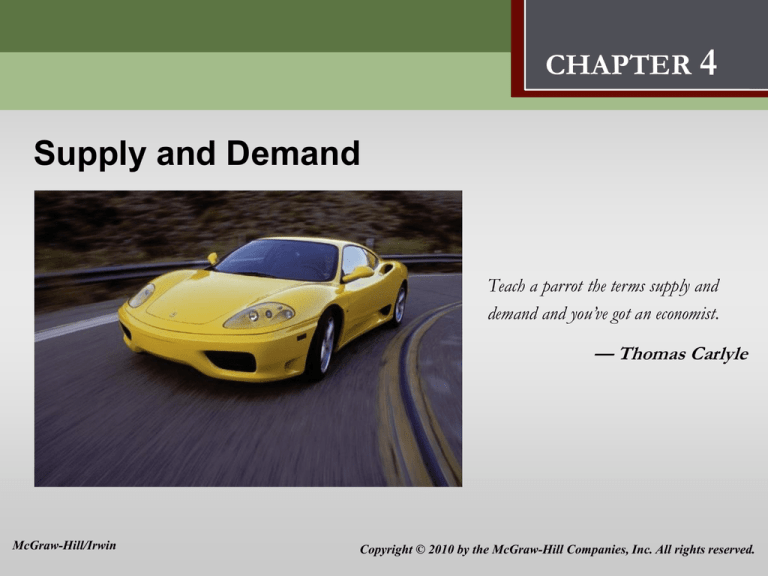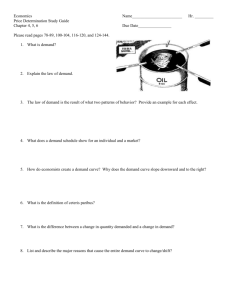
Supply and Demand
4
CHAPTER 4
Supply and Demand
Teach a parrot the terms supply and
demand and you’ve got an economist.
— Thomas Carlyle
McGraw-Hill/Irwin
Copyright © 2010 by the McGraw-Hill Companies, Inc. All rights reserved.
Supply and Demand
4
Chapter Goals
• State the law of demand and draw a demand curve
from a demand table
• Explain the importance of substitution to the laws of
supply and demand
• Distinguish shifts in demand from movements along
a demand curve
• State the law of supply and draw a supply curve
from a supply table
4-2
Supply and Demand
4
Chapter Goals
• Distinguish shifts in supply from movements along
a supply curve
• Explain how the law of demand and the law of
supply interact to bring about equilibrium
• Show the effect of a shift in demand and supply on
equilibrium price and quantity
• State the limitations of demand and supply analysis
4-3
Supply and Demand
4
Demand
• The law of demand states that the quantity of a good
demanded is inversely related to the good’s price
• In other words, other things equal,
• Quantity demanded rises as price falls
• Quantity demanded falls as price rises
• As prices change, people change how much they’re
willing to buy
• The law of demand is based on the fact that when
prices for a good rise, people substitute away from
that good to other goods
4-4
Supply and Demand
4
The Demand Curve
P
A demand curve is the graphic representation of the
relationship between price and quantity demanded
The demand curve is
downward sloping
P1
As price increases,
quantity demanded
decreases
P0
Demand
Q1
Q0
Q
4-5
Supply and Demand
4
Shifts in Demand versus Movements Along a
Demand Curve
Quantity demanded refers to a specific amount that will be
demanded per unit of time at a specific price, other things
constant
• Refers to a specific point on the demand curve
• A change in price changes quantity demanded
• A change in price causes a change in quantity
demanded
• A change in price causes a movement along
the demand curve
4-6
Supply and Demand
4
Shifts in Demand versus
Movements Along a Demand Curve
Demand refers to a schedule of quantities of a good that
will be bought per unit of time at various prices, other things
constant
• Refers to the entire demand curve
• Demand tells us how much will be bought at various
prices
• A change in anything other than price that affects
the demand curve changes the entire demand curve
• A change in the entire demand curve is a shift in
demand
4-7
Supply and Demand
4
Shifts in Demand versus Movements Along a
Demand Curve
P
$2
Movement along a demand curve
A change in price
causes a movement along
the demand curve
B
A
$1
Demand
100
200
Q
4-8
Supply and Demand
4
Shifts in Demand versus
Movements Along a Demand Curve
P
Shift in demand
A change in a shift factor
causes a shift in demand
$1
B
150
A
200
Demand0
Demand1
Q
4-9
Supply and Demand
4
Shift Factors in Demand
Important demand shift factors include:
1. Society’s income
2. The prices of other goods
3. Tastes
4. Expectations
5. Taxes and subsidies to consumers
4-10
Supply and Demand
4
Application: Demand Shift
P
What happens to demand for CDs if you won
$1 million in the lottery?
Demand would shift out to
the right because your
income increased
Demand1
Demand0
Q
4-11
Supply and Demand
4
From a Demand Table to a Demand Curve
P
$4.00
E
D
$3.00
Demand
for DVDs
C
$2.00
B
$1.00
2
4
6
8
A
10
Price per
DVD
DVD rentals
demanded per
week
A
$0.50
9
B
$1.00
8
C
$2.00
6
D
$3.00
4
E
$4.00
2
Q
4-12
Supply and Demand
4
Individual and Market Demand Curves
+
Bruce’s
demand
+
Carmen’s
demand
=
Price per
DVD
Alice’s
demand
$1.00
8
5
1
14
$2.00
6
3
0
9
$3.00
4
1
0
5
$4.00
2
0
0
2
Market
demand
4-13
Supply and Demand
4
Individual and Market Demand Curves
Market demand curve for DVDs per week
P
The market demand curve
is the summation of all
individual demand curves
$4.00
$3.00
Market demand
for DVDs
$2.00
$1.00
CARMEN BRUCE
2
4
6
ALICE
8
10
11
12
13
14
Q
4-14
Supply and Demand
4
Supply
• The law of supply states that the quantity of a good
supplied is directly related to the good’s price
• In other words, other things equal,
• Quantity supplied rises as price rises
• Quantity supplied falls as price falls
• The law of supply occurs because:
• When prices rise, firms substitute production
of one good for another
• Assuming firm’s costs are constant, a higher
price means higher profit
4-15
Supply and Demand
4
The Supply Curve
P
A supply curve is the graphic representation of the
relationship between price and quantity supplied
Supply
The supply curve is
upward sloping
P1
As price increases,
quantity supplied
increases
P0
Q0
Q1
Q
4-16
Supply and Demand
4
Shifts in Supply versus
Movements Along a Supply Curve
Quantity supplied refers to a specific amount that will be
supplied per unit of time at a specific price, other things
constant
• Refers to a specific point on the supply curve
• A change in price changes quantity supplied
• A change in price causes a change in quantity
supplied
• A change in price causes a movement along
the supply curve
4-17
Supply and Demand
4
Shifts in Supply versus
Movements Along a Supply Curve
Supply refers to a schedule of quantities of a good a seller
is willing to sell per unit of time at various prices, other
things constant
• Refers to the entire supply curve
• Supply tells us how much will be sold at various
prices
• A change in anything other than price that affects
the supply curve changes the entire supply curve
• A change in the entire supply curve is a shift in
supply
4-18
Supply and Demand
4
Shifts in Supply versus
Movements Along a Supply Curve
Movement along a supply curve
P
Supply
$80
A change in price
causes a movement along
the supply curve
$50
4.1
4.6
Q
4-19
Supply and Demand
4
Shifts in Supply versus
Movements Along a Supply Curve
P
Shift in Supply
S0
S1
A change in a shift factor
causes a shift in supply
Q
4-20
Supply and Demand
4
Shift Factors in Supply
Important supply shift factors include:
1. Price of inputs
2. Technology
3. Expectations
4. Taxes and subsidies
4-21
Supply and Demand
4
Individual and Market Supply Curves
+
Barry’s
supply
+
Charlie’s
supply
=
Price per
DVD
Ann’s
Supply
$1.00
2
1
0
3
$2.00
4
3
0
7
$3.00
6
5
0
11
$4.00
8
5
2
15
Market
supply
4-22
Supply and Demand
4
Individual and Market Demand Curves
Market supply curve for DVDs per week
The market supply curve is the
summation of all individual supply curves
P
$4.00
CHARLIE
BARRY
ANN
$3.00
Market supply
for DVDs
$2.00
$1.00
2
4
6
8
10
11
12
13
14 15
Q
4-23
Supply and Demand
4
The Interaction of Supply and Demand
• Equilibrium is a concept in which opposing
dynamic forces cancel each other out
In the free market, the forces of supply and demand
interact to determine:
• Equilibrium quantity is the amount bought and
sold at equilibrium price
• Equilibrium price is the price toward which the
invisible hand drives the market
4-24
Supply and Demand
4
The Interaction of Supply and Demand
• If there is an excess supply (a surplus),
quantity supplied is greater than quantity demanded
• If there is an excess demand (a shortage),
quantity demanded is greater than quantity supplied
• Prices adjust and tend to rise when there is excess
demand and fall when there is excess supply to
reach an equilibrium
4-25
Supply and Demand
4
The Interaction of Supply and Demand
P
Excess
supply
Supply
P1
Excess supply
causes downward
pressure on price
P*
Excess demand
causes upward
pressure on price
P0
Excess
demand
Demand
Q
4-26
Supply and Demand
4
Shifts in Supply and Demand
• Shifts in either supply or demand change equilibrium price
• An increase in demand or a decrease in supply
• Creates excess demand at the original equilibrium
price
• Excess demand increases price until a new higher
equilibrium prince is reached
• A decrease in demand or an increase in supply
• Creates excess supply at the original equilibrium
price
• Excess supply decreases price until a new lower
equilibrium price is reached
4-27
Supply and Demand
4
Application: A decrease in supply
P
S1
S0
A decrease in supply
generates excess
demand. Price will
increase until a new,
higher, equilibrium
price is reached
P1
P0
Excess
demand
D0
Q1
Q0
Q
4-28
Supply and Demand
4
Application: A decrease in demand
P
S0
Excess
supply
A decrease in demand
generates excess supply.
Price will decrease until a
new, lower, equilibrium
price is reached
P0
P1
D0
D1
Q1
Q0
Q
4-29
Supply and Demand
4
Limitations of Supply and Demand Analysis
• Sometimes supply and demand are interconnected
• The other things held constant assumption is not likely
to hold when the goods represent a large percentage
of the entire economy
• The fallacy of composition is the false assumption that
what is true for a part will also be true for the whole
4-30
Supply and Demand
4
Chapter Summary
• The law of demand states that the quantity demanded
rises as price falls, other things constant
• The law of supply states that the quantity supplied rises
as price rises, other things constant
• The laws of demand and supply hold true because
people can substitute
• A change in quantity demanded (supplied), caused by
only a change in the good’s own price, is a movement
along the demand (supply) curve
• A change in demand (supply) is a shift of the entire
demand (supply) curve
4-31
Supply and Demand
4
Chapter Summary
• Factors that affect supply and demand other than price
are called shift factors
• Important supply shift factors include price of inputs,
technology, expectations, and taxes and subsidies
• Important demand shift factors include society’s income,
the price of other goods, tastes, expectations, and taxes
and subsidies to consumers
• A market demand (supply) curve is the horizontal sum of
all individual demand (supply) curves
• When quantity demanded equals quantity supplied at
equilibrium, prices have no tendency to change
4-32
Supply and Demand
4
Chapter Summary
• When quantity demanded is greater than quantity
supplied, prices tend to rise
• When quantity supplied is greater than quantity
demanded, prices tend to fall
• When the demand curve shifts to the right (left),
equilibrium price rises (declines) and equilibrium
quantity rises (falls)
• When the supply curve shifts to the right (left),
equilibrium price decline (rises) and equilibrium
quantity rises (falls)
4-33
Supply and Demand
4
Preview of Chapter 5:
Using Supply and Demand
• Explain real-world events using supply and demand
• Discuss how exchange rates are determined
• Demonstrate the effect of a price ceiling and price floor
• Explain the effects of excise taxes and tariffs
• Explain the effect of a third-party-payer system
4-34








